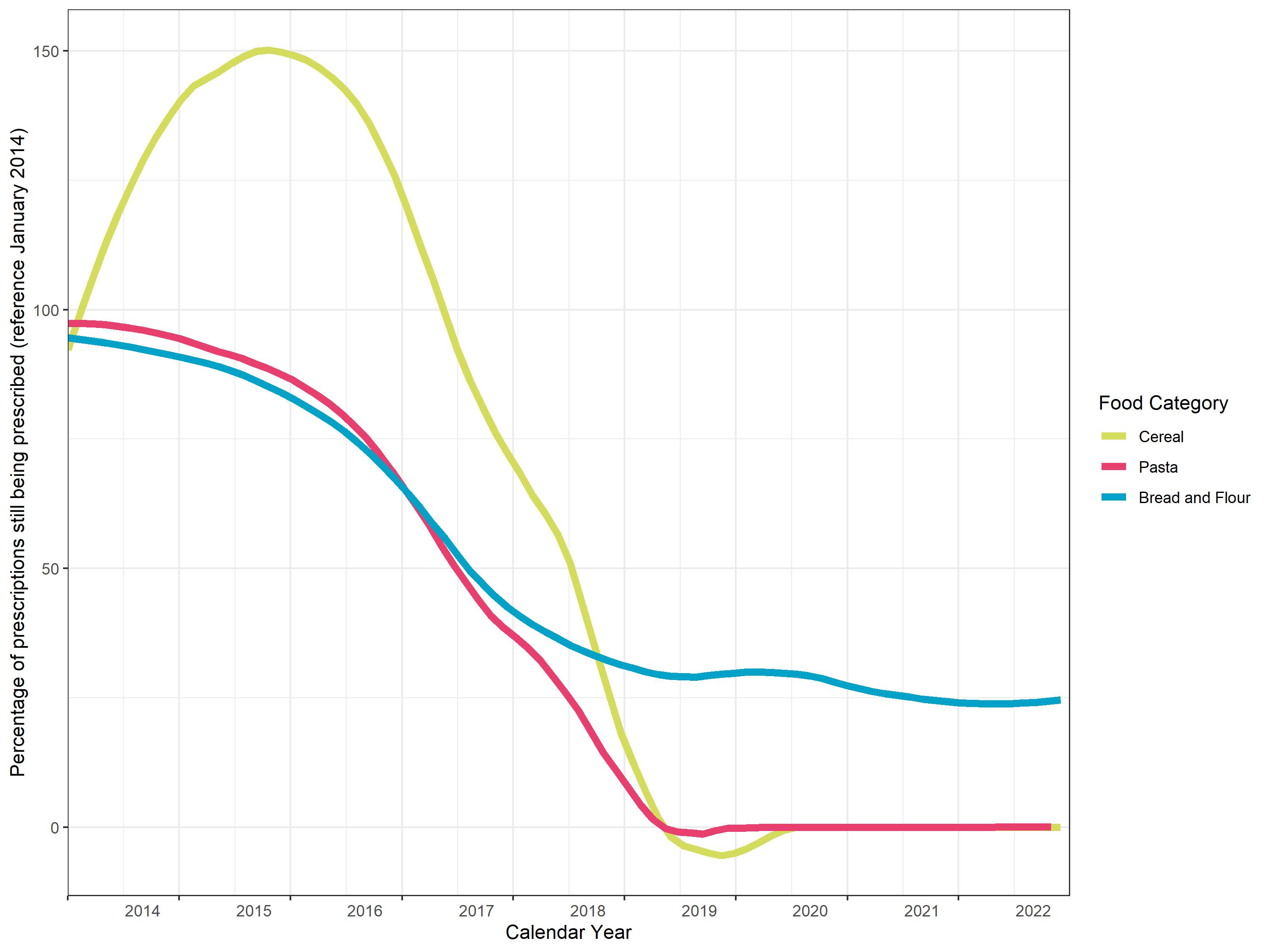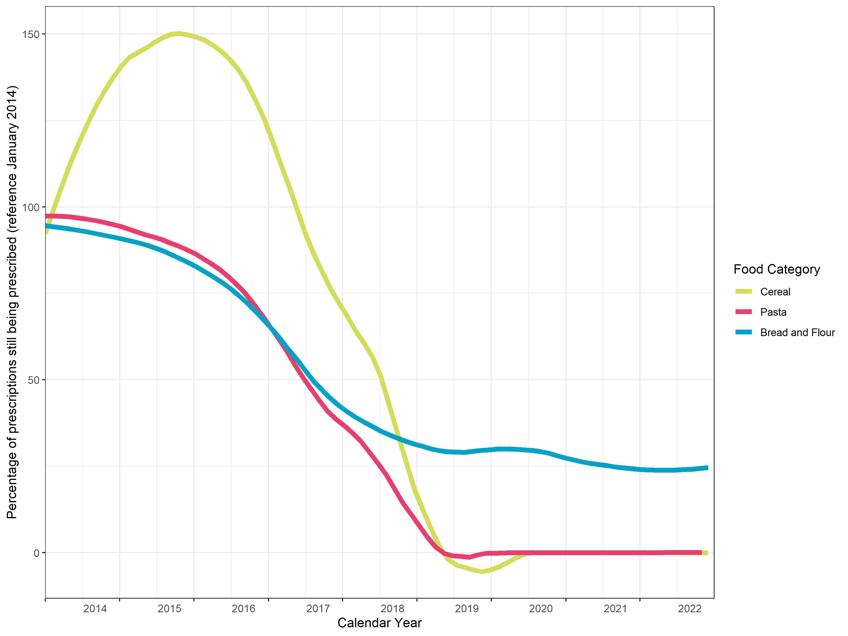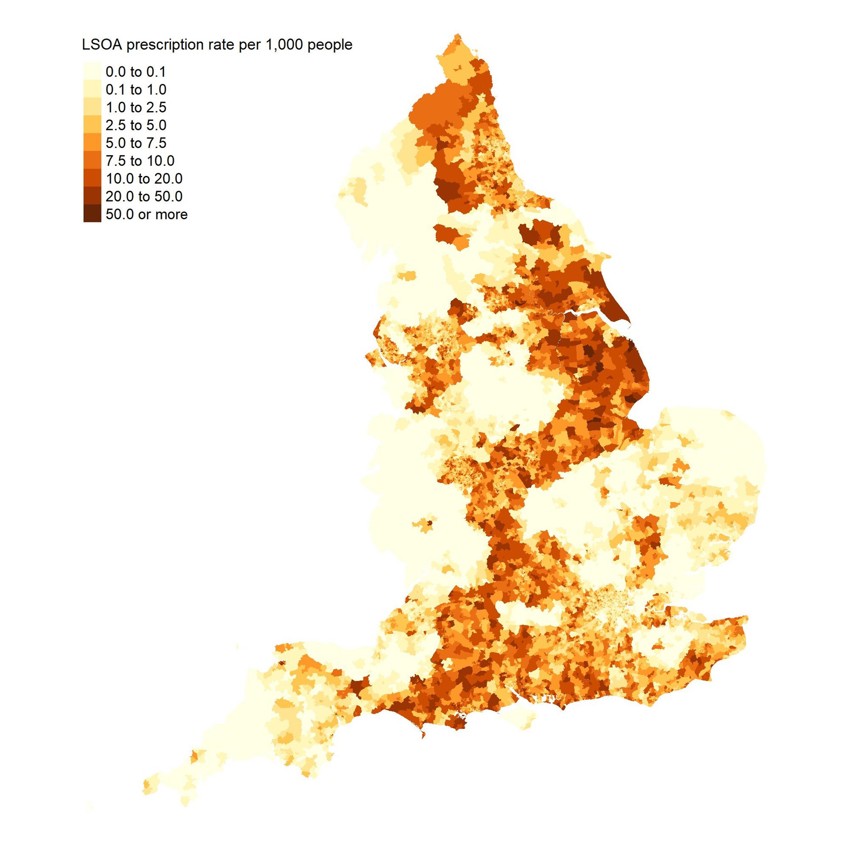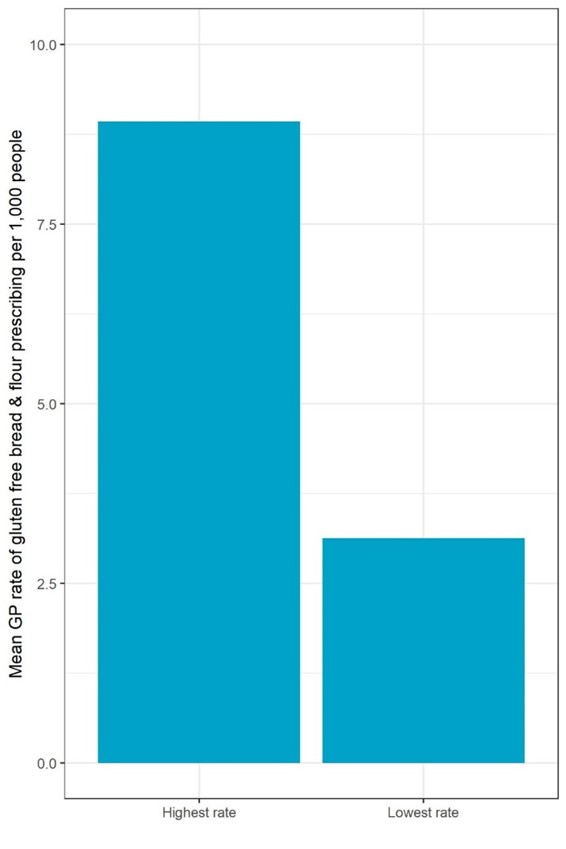One year on:
The postcode lottery of gluten free prescribing
Our viewpoint
16 May 2023
 Last year at the infancy of the cost of living crisis we looked at how the cost of gluten free foods and reducing prescription numbers may affect people who require a gluten free food to live healthily.
Last year at the infancy of the cost of living crisis we looked at how the cost of gluten free foods and reducing prescription numbers may affect people who require a gluten free food to live healthily.
This year for coeliac awareness week we once again investigate how people who require gluten free food continue to be impacted by the cost of living crisis and whether there is variation at the local level in prescribing of gluten free foods between GP practices.
What is coeliac disease?
Coeliac disease is an autoimmune disease in which a person’s body attacks itself in response to the intake of gluten, which is found in wheat, barley and rye. If someone with coeliac disease eats or has a drink containing gluten, the initial autoimmune reaction can vary from no symptoms to severe fatigue with brain fog, requiring up to a week off work in some cases. The most common symptoms are fatigue, weight loss and diarrhoea, but there are also long-term consequences for peoples’ health, including a higher risk of other autoimmune diseases and bone disorders such as osteoporosis, and a corresponding impact on the wider health care system.
Coeliac disease affects about 1 in 100 people, although only about 36% are currently diagnosed, and, for the vast majority, stopping eating gluten clears up all symptoms of the disease. However, to prevent symptoms reappearing, a lifelong gluten free diet is required.
Gluten free foods in supermarkets continue to be substantially higher than gluten containing foods
The cost of gluten free food remains high with gluten free breads costing approximately 3.5 times breads containing gluten and basic gluten free cereals such as cornflakes costing nearly 4 times store brand cornflakes. For many of these food types, only one size of package is available making bulk buying these items impossible.
|
Section |
Available on prescription |
2022 cost ratio |
Item – Gluten free |
Cost – Gluten free |
Equivalent item – with gluten |
Cost – with gluten |
2023 cost ratio |
Change in gluten free cost (per kg) since 2022 |
|
Bread |
Yes |
3.93 |
Genius gluten free toastie – 430g |
£2.75 |
Warburtons Toastie Sliced Bread – 800g |
£1.40 |
3.65 |
£1.00 |
|
4.80 |
Tesco free from sliced bread – 550g |
£1.95 |
Tesco white bread – 800g |
£0.85 |
3.34 |
-£0.05 |
||
|
Pasta |
No |
1.33 |
Tesco free from fusilli – 500g |
£1.20 |
Tesco Fusilli pasta – 500g |
£0.95 |
1.26 |
£0.40 |
|
Cereal |
No |
1.23 |
Nutribrex gluten free (24 pack, 375g) |
£4.00 |
Weetabix Cereal – 24 pack |
£3.25 |
1.23 |
£0.30 |
|
2.50 |
Tesco free from cornflakes – 300g |
£1.50 |
Tesco cornflakes – 500g |
£0.63 |
3.97 |
£2.00 |
Prescribing of gluten free foods remains low
Last year we reported the changes in gluten free prescribing between January 2014 and November 2021. This year we’ve extended our analysis to December 2022. A similarly stark picture is painted, with prescribing remaining at about 25% of January 2014 levels. Prescribing of pastas and cereals remain at 0%.

The postcode lottery of gluten free prescribing
An additional analysis we wanted to look at this year was whether there was a postcode lottery around gluten free prescribing, i.e. if you live in a different area would you be more likely to get a prescription. Prescription rates of gluten-free breads, and flours vary greatly across England, with vast prescription deserts in the South-West, West Midlands, North-West, and East of England, likely due to restrictions on prescribing these foods in these areas. For example, NHS Cornwall and Isles of Scilly does not support the supply of any gluten-free food on prescription and hasn’t done so since 2016.
Diving deeper, we can also see significant differences within regions and cities. For example, for residents of Newcastle and the surrounding area, some neighbourhoods received as many as 20 times more gluten-free prescriptions than others. The analysis highlights that where you live, not just regionally, but also locally, can drastically impact opportunities to access to gluten-free prescriptions.
Last year, we examined the association between prescribing rates and deprivation, and there was little evidence to suggest that prescription rates increased or decreased with changes in deprivation levels. This means that people living in the most deprived neighbourhoods’ risk being unable to access the gluten-free foods they require to follow a healthy diet due to a mix of lack of money and lack of prescriptions.

Your choice of GP practice could affect the likelihood of gluten free prescriptions being available
However simply comparing LSOAs doesn’t tell the whole story. Patients in a local area sometimes have a choice of which GP practice they attend. We therefore also looked to see whether there are differences within postcode sectors (the first part of a postcode plus the first number e.g. “W1U 1”). Indeed there are multiple GP surgeries with nearly a 3-fold difference between the average of the highest prescribing practice compared to the lowest prescribing practice.
One such example is the “B8 3” postal sector in Birmingham where on of the highest prescribing GP practices prescribe gluten free foods at a rate of 187 items per 1,000 patients per year. In comparison, the lowest prescribing practice in the same postal sector only prescribes 2.7 items per 1,000 patients per year, approximately 1/70th of the rate of the highest prescribing practice. Whilst some difference may be due to different number of patients with coeliac disease at the different practices it is unlikely this large difference is due to this alone given the similar populations accessing these practices.

Summary
At a time when many households across the UK continue to face the challenge of rising costs of living, regional and local differences in access to gluten free foods could mean people living with coeliac disease must choose between poor health or money shortages. Evidently improvements at a local level can be made, with increasing awareness amongst GPs for options for prescribing gluten free food a potential quick win. Unless broader changes are also made to enable equitable access to gluten free foods, it is likely that patients with coeliac disease will have a greater impact on the national health system in the future due to poor health from lack of access to the foods they need.
Originally written with Danielle Robinson and Simon Chen

